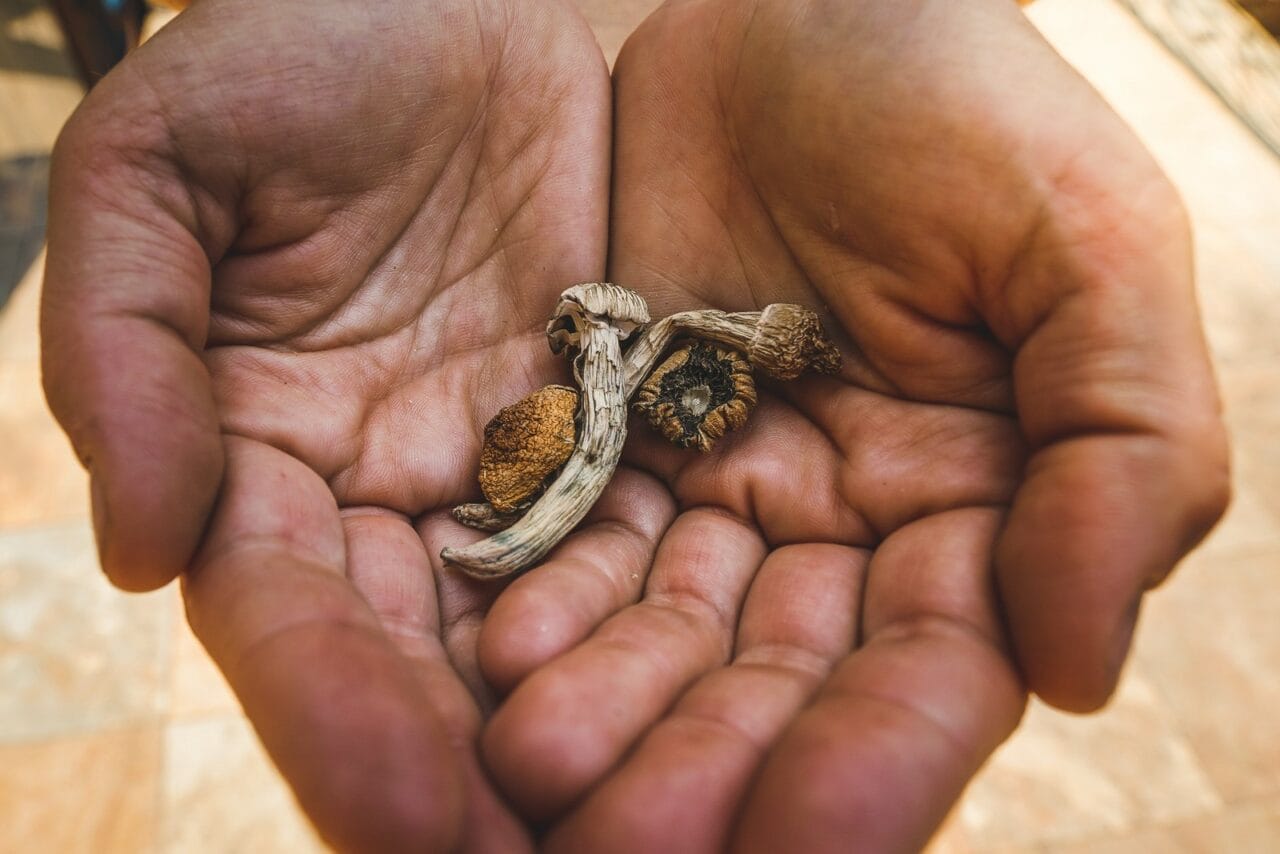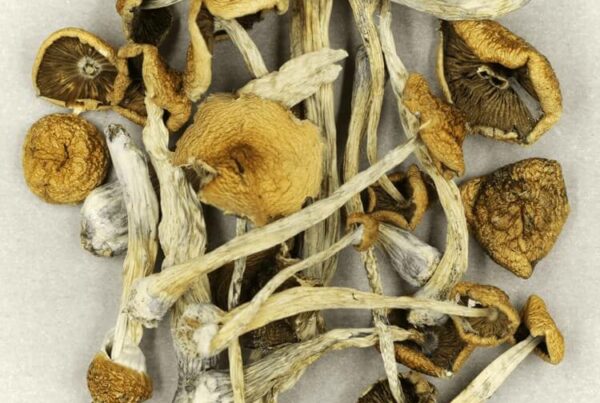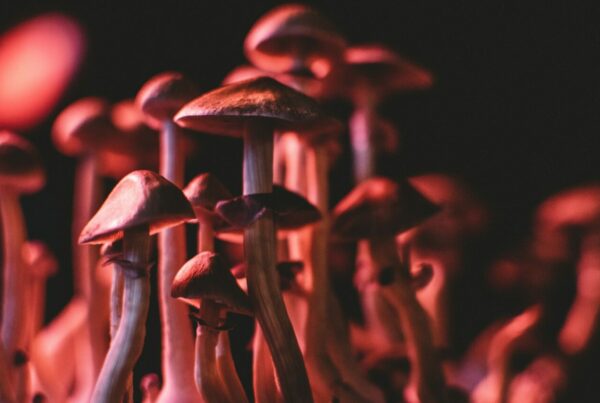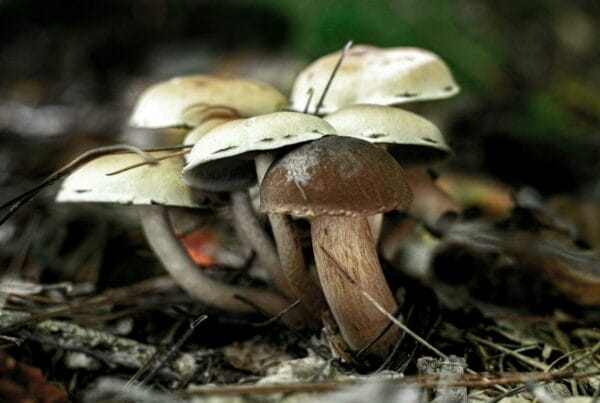Considering trying dried shrooms but unsure if they’re the right choice for you? You’re not alone. Many beginners are uncertain about which psychedelic substance to try first.
Let us help you understand how dried mushrooms stand apart from other options and why they might be the perfect starting point for your first psychedelic experience.
[toc]Main Points:
- Psilocybe’s active compound is the most studied psychedelic for mental health due to its safety, low risk of misuse, and ephemeral effects.
- Frequently, Psilocybe comes in a dehydrated form, which keeps its potency intact and extends its shelf life.
- Psilocybin activates the serotonin 5-HT2A receptor, leading to enhanced perception, vivid imagery, intricate hallucinations, and time distortions.
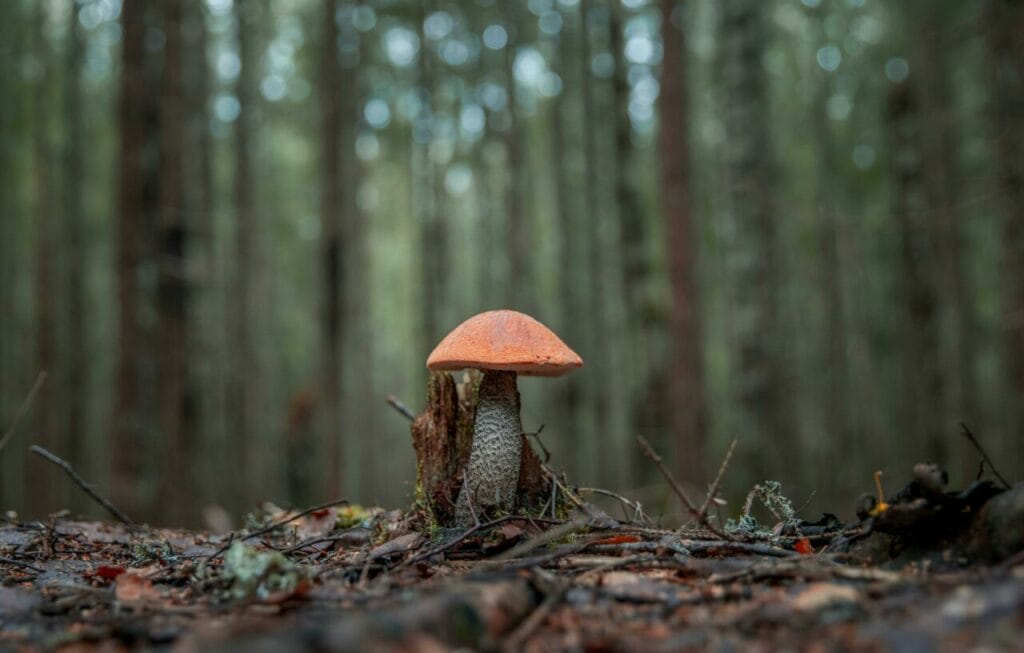
Understanding Psilocybin Mushrooms: Exploring the World of Psychedelic Fungi
Psilocybin mushrooms are rich in psychoactive compounds, psilocybin and psilocin, responsible for the hallucinogenic effects experienced by users. The most recognized species—Psilocybe cubensis—features a light brown cap, dark spots, and a distinct shape. More species within the Psilocybe genus also produce these compounds.
Some toxic mushrooms, which contain dangerous toxins, resemble Psilocybe’s appearance. We strongly recommend against wild mushroom picking due to this reason.
Historically, various mushrooms played a significant role in Central American spiritual practices. Today, their potential as a treatment for mental health ailments, including substance use disorders, is under scientific examination.
Understanding Dehydration: The Preservation Process
The most commonly encountered form of Psilocybe is dried. The dehydration process is essential to preserving the mushrooms’ potency and extending their shelf life. Fresh mushrooms are typically dried using a food dehydrator or left on a wire rack in a cool, dry setting.
This process is imperative for removing excess
Drying Magic mushrooms allows for long-term preservation by preventing moisture, which can lead to mold growth and compound degradation.
Follow this step-by-step guide to dry and store magic mushrooms effectively:
- Use a suitable food dehydrator or a wire rack to thoroughly dry the mushrooms.
- Preserve them in airtight containers to shield from moisture and maintain their potency.
- Store in a dry, cool place to sustain their psychoactive properties.
- Avoid exposing them to direct sunlight to prevent degradation.
- Inspect regularly for mold or dark spots, which indicate spoilage.
Comparing Psilocybe Cubensis with Other Psychedelics
In addition to dried mushroom products, several other psychedelic products are available online. These substances produce different effects on the body and are consumed diversely. Some of these substances are classified as classic hallucinogens, akin to psilocybin.
| Substance | Source | Physical Effects | Potential Use in Research | Duration of Effect |
| Psilocybin | Present naturally in over 200 mushroom species | Enhances perception, induces hallucinations, changes sense of time | Depression, Anxiety, PTSD, OCD, Cluster headaches, Alzheimer’s disease | 4-6 hours |
| DMT | Naturally found in plants such as Psychotria viridis | Provokes spiritual experiences, visions, auditory hallucinations | Depression, Addiction | 15-30 minutes |
| LSD | Synthetic, first produced by Albert Hofmann in 1938 | Intensifies emotions, alters perception, triggers auditory and visual hallucinations | Depression, Anxiety, Addiction, Cluster headaches, Alzheimer’s disease, Tourette’s syndrome, ADHD | 8-12 hours |
| MDMA | Synthetic, originally synthesized by Anton Köllisch in 1912 | Increases release of serotonin, dopamine, norepinephrine, and possibly oxytocin | PTSD, Autism spectrum disorder, Obesity, Narcolepsy, ADHD | 3-6 hours |
| Ketamine | Synthetic, first developed by Calvin L. Stevens in 1962 | Anesthetic, induces psychedelic effects at high subanesthetic doses | Depression, Bipolar disorder, Anxiety, Suicidal ideation, Addiction, Autism spectrum disorder, Chronic pain, Arthritis, Fibromyalgia | 1-3 hours |
How Does Your Body Respond?
The functioning of each substance is hypothetical and based on observed effects. These hypotheses offer a glimpse into how these substances might function, but do not give a conclusive understanding of the underlying mechanisms at play.
- Psilocybin: It easily stimulates the serotonin 5-HT2A receptor, leading to enhanced perception, vivid imagery, complex hallucinations, and time distortions. It also provokes changes in thalamic gating and increased prefrontal cortex activity.
- DMT: Its interaction with serotonin receptors is part of its overall effect, the full scope of which is still unknown. The serotonin receptor is vital but cannot entirely account for all DMT’s effects.
- LSD: It works within the serotonergic system in the Dorsal Raphe, attaching to the 5-HT2A receptor as a partial agonist and the 5-HT1A receptor as a full agonist.
- MDMA: It provokes an immediate feeling of joy by facilitating the discharge of dopamine and serotonin.
- Ketamine: Its exact mode of operation is uncertain. Its antidepressant effect could be due to the blocking of NMDA receptors on neurons, but the selective inhibition of NMDA receptors on GABAergic interneurons and the reduction of AMPA receptors may also contribute.
What Can Psychedelic Mushrooms Do to You?
The mental and physical effects can vary significantly based on dosage, environment, and the user’s psychological state. Common experiences associated with the consumption of psychedelic mushrooms include:
- Visual and Auditory Hallucinations: Users may see patterns, colors, and shapes that aren’t present in reality.
- Distorted Perception of Time: Time might appear to elongate or shrink.
- Altered Perception: Sensory experiences may be amplified or distorted.
- Emotional Swings: Users can experience a wide range of emotions, from euphoria to anxiety.
- Spiritual Insights: Users may have spiritual or mystical experiences.
- Physical Effects: Symptoms may include an increase in heart rate and blood pressure, or feelings of sickness
While shrooms are generally considered safe when used responsibly, lack of proper preparation can lead to unpleasant experiences for some individuals. Experienced users may benefit from higher doses, but newcomers attempting to consume large amounts may experience a distressing “bad trip.”
Managing your experience with this substance is easy. Choose a calm, quiet setting and enlist the help of a sober “trip guide” if needed.
A Preferred Alternative to Other Substances
Dried shrooms are often preferred by medical professionals due to their long shelf life and easy dosing. The shorter duration and more manageable intensity make it an appropriate option for those new to psychedelic therapy. It is also more organic than other synthetic hallucinogens, except for DMT.
It can be challenging to distinguish the benefits of different compounds, as many clinical trials produce similar outcomes, particularly between LSD and psilocybin. The latter is the most extensively researched psychedelic for mental health issues, mainly due to its impressive safety track record, low abuse risk, and short perceptual trips.
Health Benefits
- This natural substance can potentially reduce “cognitive rigidity,” lessen negative thought patterns, and promote self-compassion.
- A 2022 study found that a single 25 mg dose reduced depression scores in individuals with treatment-resistant depression. A 2023 study reported significant and sustained reductions in depressive symptoms when using controlled substances in conjunction with psychotherapy.
- A 2022 clinical trial found that psilocybin-assisted psychotherapy significantly reduced the number of heavy drinking days over an eight-month period compared to a placebo.
- A 2017 study published in the American Journal of Drug and Alcohol Abuse revealed that two to three doses, along with cognitive behavioural therapy (CBT), helped 10 out of 15 participants quit smoking for a year.
- In a 2022 pilot study published in Biological Psychiatry, four out of five patients with anorexia reported an improvement in their eating disorder symptoms after a single dose of shroom combined with psychotherapy. Two of these patients also reported decreased anxiety.
- Preparation Phase: In this initial stage, you’ll have one or more sessions (each lasting 1-6 hours) with a facilitator. The objective is to address your concerns, identify your goals, and set transparent expectations. This phase is vital in building trust and creating a safe environment.
- Dosing Phase: This stage lasts between 5-8 hours. You’ll spend it lying down, with an eye mask on, and listening to a preselected playlist. A therapist will accompany you throughout the entire experience.
- Integration Phase: This is the final stage, which includes follow-up meetings to help you understand and interpret your experience. These sessions are spread over several meetings, each lasting several hours.
Are shroom products more economical than other substances?
When compared to LSD products, dried fungi are considerably more affordable. For instance, you can acquire 3.5 grams for around $20. In contrast, the cost of LSD in gel tabs can vary depending on the dosage. As an example, six tabs, each with a potency of 100 micrograms, could cost roughly $90.

